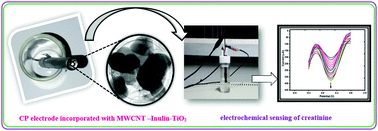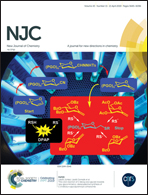Enzyme-less sensing of the kidney dysfunction biomarker creatinine using an inulin based bio-nanocomposite†
Abstract
Creatinine is a kidney dysfunction biomarker, and its sensing properties have become an important tool in the diagnosis of abnormal kidney function. In the present study, a new enzyme-less creatinine sensor was developed by the bulk modification of carbon paste with the as-prepared inulin-based bio-nanocomposite. The electrochemical sensing of creatinine was conducted using the a sensor that exhibited two linear working ranges of 0.2 μM to 1 μM and 0.05 mM to 12 mM with the corresponding limits of detections of 60 nM and 90 μM. The sensitivity (204 mA mM cm−2), selectivity (in presence of other interferences like glucose, urea, ascorbic acid and uric acid) and stability (240 days) were also established. The sensitivity of the fabricated electrode was further validated by the determination of creatinine in urine samples spiked with various concentrations of creatinine. The analytical performance of the electrode was compared with that of the standard spectrophotometric method. This implied the better sensitivity of the fabricated sensor with nM-level sensing, which is a million times higher than that obtained using the spectrophotometric method.



 Please wait while we load your content...
Please wait while we load your content...